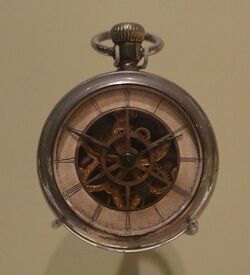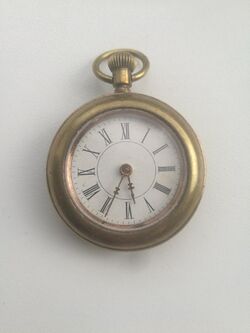Engineering:Dollar watch
A dollar watch was a pocket watch or later, a wristwatch, that sold for about one US dollar.
History of development
Attempts to make a watch that could be sold for as little as a dollar began in the 1870s.[1] By 1880, the Waterbury Watch Company, not to be confused with the Waterbury Clock Company, had lowered costs to the point where they could sell their so-called long wind watch for $3.50.[1] In the early 1890s the Ingersoll Watch Company started selling a Waterbury Clock Company clock in a watch case for $1.50.[1][2][3]
The one dollar price was reached in 1896 when Ingersoll introduced a watch called the Yankee, setting its price at $1. This made it the cheapest watch available at the time, and the first watch to be priced at one dollar.[4]
Later, Western Clock (Westclox) in 1899 and the E. Ingraham Company also began manufacturing them. Dollar watches were practical, mass-produced timepieces intended to be as inexpensive as possible.
Features of dollar watches were their simple, rugged design, movement (usually with a pin-pallet escapement, although sometimes with duplex escapements) which has either no jewels or just one jewel, width of about eighteen size (2 inches (51 mm)), and sale price of about a dollar from 1892 until the mid-1950s. Many other companies made them, with literally hundreds of names on the dials. From around 1905, Ingersoll started selling their watches in the UK as Crown watches.[1]
To keep costs down, the watches were often sold in flimsy cardboard boxes, which are now highly collectible.[citation needed]
See also
References
- ↑ 1.0 1.1 1.2 1.3 Bruton, Eric (2000). The History of Clocks & Watches. Little, Brown and Company. pp. 186–189. ISBN 0316853550.
- ↑ https://pocketwatchdatabase.com/guide/trade-names/yankee
- ↑ https://www.timesticking.com/the-watch-that-made-the-dollar-famous/
- ↑ Cutmore, M. "Watches 1850–1980". David & Charles, Devon, UK. 2002.
 |



